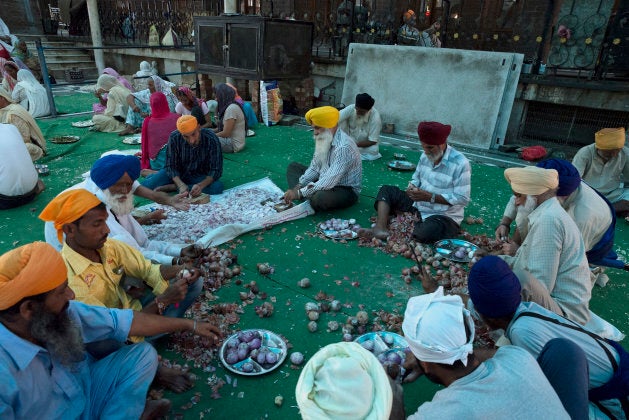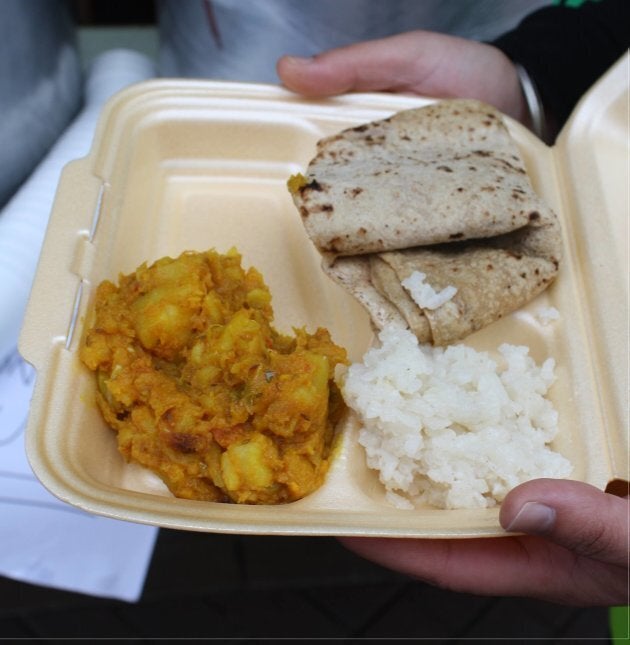
More than 1.1 million Canadian households experience food insecurity. This means at least four million Canadians at one time or another have been unsure of where their next meal is coming from.
This news is heart-breaking and of great concern to all Canadians, but it is even more disappointing for Canadian Sikhs to hear — and that's because we believe where there are Sikhs, no one should go hungry.
Wherever there are Sikhs, there is langar. Langar is the free communal kitchen service that is part of every single gurdwara (Sikh place of worship and education) in the world. Langar is also served on the streets to ensure it reaches those that may need it most. Through this completely voluntary service funded entirely by donations (of both food and money), Sikhs serve an estimated seven million meals a day all over the world, according to estimates from the Sikh Press Association.
You may find a doctor sitting on the floor next to a homeless person next to a student, all eating the same food.
We recently observed international Langar Week, an annual campaign of the Sikh Press Association aimed at both tackling issues of hunger and educating the public on Sikh philosophy. Sikhs recognize that not enough people know about langar. This service is not just for Sikhs; it is for anyone who needs it. Langar is there to fight hunger (and, coincidently, rhymes with it too), and therefore it is a Sikh's duty to let people know about langar.
Langar started in the late 1400s when a young Guru Nanak Dev Ji Maharaj, the first Guru of the Sikhs, was asked to seek a profit by his father in an effort to teach him entrepreneurial skills. As such, young Nanak was given 20 rupees to go and buy something to trade with. Money in hand, on the way to the market Nanak came across holy men who were suffering from hunger. Nanak decided that providing food for them was a worthy cause to invest in. Returning home empty handed, Nanak was scolded by His father.
Despite this, He explained that by feeding the needy He had actually used the money to get the highest return possible. With such tales embedded in the Sikh religion, for Sikhs sharing food is normal.

In any gurdwara, langar will be served for as long as there is someone to eat it. In busier gurdwaras, this means the service may run from dawn to dusk, such as in Sri Harmandir Sahib in Amritsar, Punjab, where an estimated 100,000 people feed daily. In others, such as some of the more rural parts of Canada, this may mean it is only prepared at lunchtime. Because of the Sikh practice of Amritvela (dawn meditation), preparation for langar often begins as early as 3 or 4 a.m.
To ensure there are no barriers for anyone, whether they be religious or dietary, all langar is vegetarian (including eggless). Usually, you will find some form of dhal (lentil soup), sabji (curried vegetables) served along with rice, salad and roti.
Langar has been around for over 500 years, and by default in Canada for over 100 years since the first Sikh settlers came.
Langar is not only free to eat, it is free of stigma. In any gurdwara, you may find a doctor sitting on the floor next to a homeless person next to a student, all eating the same food at the same level. This is how langar puts the Sikh belief in equality into action.
Langar also teaches compassion through the nature of voluntary work. Seva (selfless service) is a mandatory part of Sikh practice. Being charitable for a Sikh cannot be reduced to donating money. Each Sikh should be actively engaging in grassroots seva. For many, this comes in the form of langar. Whether washing dishes, making rotis or serving food, langar engrosses anyone involved in its service in an act of compassion, by helping someone do what comes most natural to all of us: enjoying a hearty meal.

Langar has been around for over 500 years, and by default in Canada for over 100 years since the first Sikh settlers came, but the concept of taking it onto the streets in countries like Canada is relatively new. Sikhs recognize that langar should always get to those that most need it, and that's why approximately a dozen different Sikh-ethos organizations regularly take to the streets to serve it.
In British Columbia, there is the Guru Nanak's Free Langar group in Prince George, headed up by respected Sikh community figure Ranjit Singh who decided to plunge his life savings into providing this service. There is also Guru Nanak's Free Kitchen (notice how many of these groups dedicated their efforts to the teachings of the Guru) that serves across the Vancouver area, providing food and aid, and regularly running integrative community events, such as their Christmas toy drive.
In Ontario, Langar Seva go one step further and take langar directly to the homes of those that need it; literally anyone can call and ask for a meal if they feel in need. The Sikh Sewa Society of Toronto holds a weekly street feed.
There are probably millions — yes, millions — of Canadians that live right next to a gurdwara but have never been inside.
In Alberta, whilst community groups regularly use langar to build bridges between communities, Sikh-ethos group Karma Grow is building gardens to help provide organic produce for langar, food banks and anyone that may need it.
There are other groups I could name and probably more I do not know about, mainly because these organizations often go about their work in an understated way. The Sikh concepts of humility and the danger of ego means volunteers often shun the limelight. However, the Sikh Press Association encourages all of these groups to use any publicity this article generates to highlight their seva (selfless service), to help the organizations grow and to ensure people know that the service is out there and available to them.

Due to the nature of media, much of what makes the news is negative, and this is definitely the case for the Sikh community — hence the Ask Canadian Sikhs movement started by the World Sikh Organization.
One thing that has not been noted in the media about the Sikh community is the huge upturn in philanthropy. In the last five to eight years, there has been an explosion in the availability of education on the Sikh faith, thanks to groups like my very own Basics of Sikhi. This has directly resulted in Sikh engaging in more acts of charity/community, from feeding people through langar to holding open mental health awareness forums, or even showing support for Canada's indigenous community. Canadian Sikhs are doing more of it than ever.
More from HuffPost Canada:
There are probably millions — yes, millions — of Canadians that live right next to a gurdwara but have never been inside. Many of those same people may have at one time or another possibly needed access to a free meal.
So take this as an open invitation, Canadians: you are all welcome to join the Sikhs for a meal at your local gurdwara, any time, any day. We hope to see you soon.
Have you been affected personally by this or another issue? Share your story on HuffPost Canada blogs. We feature the best of Canadian opinion and perspectives. Find out how to contribute here.
Also on HuffPost: